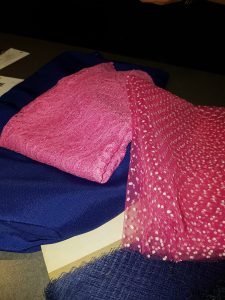 Writing books and making hats have something in common. Who knew? I certainly didn’t when I commissioned Lynda Marie http://www.lyndamariemillinery.com/to make a fascinator for me to wear to our daughter’s wedding. She knew the color of my dress (royal blue), the basic style (simple) and that I was wearing fun, in-your-face pink shoes. I wanted something elegant, I told her. Wedding guest classy, maybe with a little touch of sass.
Writing books and making hats have something in common. Who knew? I certainly didn’t when I commissioned Lynda Marie http://www.lyndamariemillinery.com/to make a fascinator for me to wear to our daughter’s wedding. She knew the color of my dress (royal blue), the basic style (simple) and that I was wearing fun, in-your-face pink shoes. I wanted something elegant, I told her. Wedding guest classy, maybe with a little touch of sass.
I was excited when she showed me some of the elements she planned to incorporate. It was going to be beautiful; I had no doubt about it.
A few weeks later she called to say it was ready. Full of anticipation, I went to her studio. The fascinator was gorgeous, I absolutely loved it, but it wasn’t what I expected. In fact, Lynda Marie ended up using almost none of the original elements she’d planned to use. “I tried,” she told me. “I really did. I kept fiddling and rearranging and trying to incorporate some of the pink polka dots and a little of the other material too, but the result just didn’t feel right.”
I know that feeling. There have been times, particularly in the early stages of a novel, where I’ll fiddle and rearrange and fiddle again. Something just doesn’t feel right. If I can’t stop fiddling, I know I need to take a step back and re-evaluate. Is the premise weak? The character’s motive flawed? Is the tone off? Am I worrying too much about whether the story will sell rather than the story I have to tell? If my gut tells me something is off, then something usually is off. Gut feelings rarely steer you wrong.
The same can be said for bespoke hats. “I was trying so hard to make it work but that first creation didn’t feel elegant,” Lynda Marie says. “I was fighting with the pink polka dots and trying to force it because we’d talked about using them, but the result was nothing remotely close to what we’d envisioned.” She pauses. “Some hats come together easily and others don’t, but as my boyfriend reminded me, if I didn’t like the result then chances are you wouldn’t either.” As soon as Lynda Marie let go of what she thought she needed to do and went with what the fascinator was trying to tell her, the piece came together quickly and easily.
Sometimes we have to get out of our own way, leave our expectations at the door, and let the hat or the book or the painting or the quilt (or whatever else we’re trying to create) tell us what it wants to be. Sometimes we have to let the muse have her way.
The results, inevitably, will always be far more beautiful than we could have imagined.
